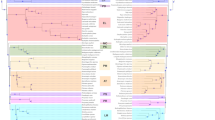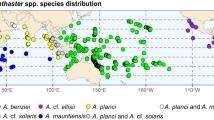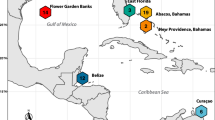Abstract
Previous studies have shown that the three-spot damselfish species complex [Dascyllus albisella Gill, D. auripinnis Randall and Randall, D. strasburgi Klausewitz, D. trimaculatus (Ruppell)] is an assemblage of five geographically distinct clades. The one exception was a single D. trimaculatus from French Polynesia, which grouped with "Pacific Rim" individuals. In the present study, an additional 252 individuals from French Polynesia collected between June 1996 and January 2002 were analyzed using PCR amplifications, restriction fragment length polymorphisms, and DNA sequencing of the mitochondrial control region. The French Polynesian D. trimaculatus belong to two distinct clades. One clade comprising 96% of the individuals includes haplotypes found only in French Polynesia. The other clade (4% of the individuals) is comprised of haplotypes that cluster with "Pacific Rim" individuals, a clade with widespread distribution from Japan to the Line Islands and from Wallis to Palau. Present data suggest that a small number of larvae from northwestern reefs (possibly Line Islands) may have occasionally reached and colonized French Polynesian reefs.


Similar content being viewed by others
References
Armsworth PR (2001) Directed motion in the sea: efficient swimming by reef fish larvae. J Theor Biol 210:81–91
Armsworth PR, James MK, Bode L (2001) When to press on or turn back: dispersal strategies for reef fish larvae. Am Nat 157:434–450
Bernardi G (2000) Barriers to gene flow in Embiotoca jacksoni, a marine fish lacking a pelagic larval stage. Evolution 54:226–237
Bernardi G, Holbrook SJ, Schmitt RJ (2001)Dispersal of the coral reef three-spot dascyllus, Dascyllus trimaculatus, at three spatial scales. Mar Biol 138:457–465
Bernardi G, Holbrook SJ, Schmitt RJ, Crane NL, DeMartini E (2002)Species boundaries, populations and colour morphs in the coral reef three-spot damselfish (Dascyllus trimaculatus) species complex. Proc R Soc Lond Ser B Biol Sci 269:599–605
Doherty PJ, Planes S, Mather P (1995) Gene flow and larval duration in seven species of fish from the Great Barrier Reef. Ecology 76:2373–2391
Hedgecock D (1994) Does variance in reproductive success limit effective population size of marine organisms? In: Beaumont A (ed) Genetics and evolution of aquatic organisms. Chapman and Hall, London, pp 122–134
Hudson RR, Slatkin M, Maddison WP (1992) Estimation of levels of gene flow from DNA sequence data. Genetics 132:583–589
Leis JM, Carson-Ewart B (1997) In situ swimming speeds of the late pelagic larvae of some Indo-Pacific coral-reef fishes. Mar Ecol Prog Ser 159:165–174
Knowlton N (2000) Molecular genetic analyses of species boundaries in the sea. Hydrobiologia 420:73–90
Planes S (1993) Genetic differentiation in relation to restricted larval dispersal of the convict surgeonfish Acanthurus triostegus in French Polynesia. Mar Ecol Prog Ser 98:237–246
Planes S, Doherty PJ (1997) Genetic and color interactions at a contact zone of Acanthochromis polyacanthus: a marine fish lacking pelagic larvae. Evolution 51:1232–1243
Planes S, Doherty P, Bernardi G (2001) Unusual case of extreme genetic divergence in a marine fish, Acanthochromis polyacanthus, within the Great Barrier Reef and the Coral Sea. Evolution 55:2263–2273
Rancher J, Rougerie F (1992) Situations océaniques du Pacifique Central Sud. SMSR, Montlhéry
Randall JE, Randall HA (2001) Dascyllus auripinnis, a new pomacentrid fish from atolls of the Central Pacific Ocean. Zool Stud 40:61–67
Riginos C, Victor BC (2001) Larval spatial distributions and other early life-history characteristics predict genetic differentiation in eastern Pacific blennioid fishes. Proc R Soc Lond Ser B Biol Sci 268:1931–1936
Rozas J, Rozas R (1999) DnaSP version 3: an integrated program for molecular population genetics and molecular evolution analysis. Bioinformatics 15:174–175
Shulman MJ, Bermingham E (1995) Early life histories, ocean currents, and the population genetics of Caribbean reef fishes. Evolution 49:897–910
Taylor MS, Hellberg ME (2003) Genetic evidence for local retention of pelagic larvae in a Caribbean reef fish. Science 299:107–109
Victor BC (1986) The duration of the planktonic larval stage of one hundred species of Pacific and Atlantic wrasses (family Labridae). Mar Biol 90:317–326
Wellington GM, Victor BC (1989) Planktonic larval duration of one hundred species of Pacific and Atlantic damselfishes (Pomacentridae). Mar Biol 101:557–567
Waples RS (1987) A multispecies approach to the analysis of gene flow in marine shore fishes. Evolution 41:385–400
Acknowledgements
We would like to thank H. Debelius, J. Randall, and P. Raimondi for discussing our results, H. Debelius for providing pictures and information about Cook Island individuals, and G. Benavides, M. Burford, N. Inokuchi, and M. Ramon for help in collecting samples. We would like to thank L. Meng, K. Andersen, and the staff of Dive Kiribati for their help at Christmas Island. This research was funded by a Faculty Development Award (UCSC Natural Sciences) to G.B., NSF grants OCE 95-03305 and OCE 99-10677 to R.S. and S.H., and a Multicampus Research Incentive Fund, University of California to G.B., S.H., and R.S.
Author information
Authors and Affiliations
Corresponding author
Additional information
Communicated by J.P. Grassle, New Brunswick
Rights and permissions
About this article
Cite this article
Bernardi, G., Holbrook, S.J., Schmitt, R.J. et al. Genetic evidence for two distinct clades in a French Polynesian population of the coral reef three-spot damselfish Dascyllus trimaculatus . Marine Biology 143, 485–490 (2003). https://doi.org/10.1007/s00227-003-1091-y
Received:
Accepted:
Published:
Issue Date:
DOI: https://doi.org/10.1007/s00227-003-1091-y




